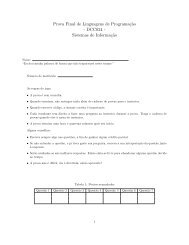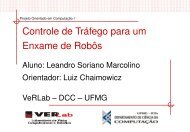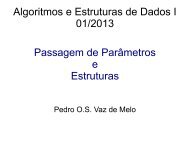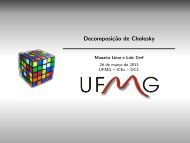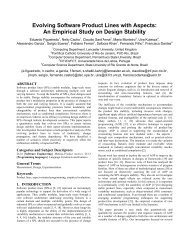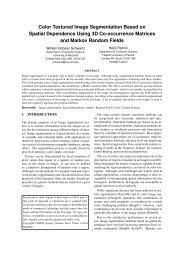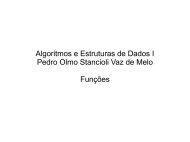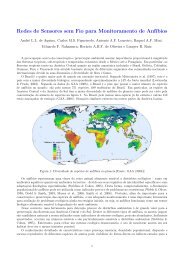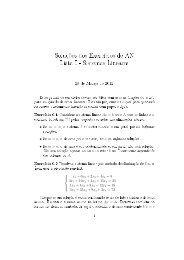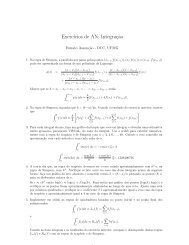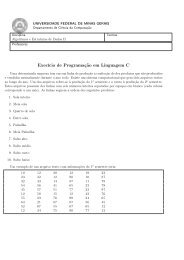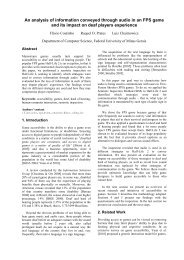Simple and Space-Efficient Minimal Perfect Hash Functions * - Liacs
Simple and Space-Efficient Minimal Perfect Hash Functions * - Liacs
Simple and Space-Efficient Minimal Perfect Hash Functions * - Liacs
You also want an ePaper? Increase the reach of your titles
YUMPU automatically turns print PDFs into web optimized ePapers that Google loves.
The first two results assume uniform r<strong>and</strong>om hash functions to be available<br />
for free. Czech et al [16] proposed a family of algorithms to construct MPHFs<br />
based on r-uniform hypergraphs (i.e., with edges of size r). The resulting functions<br />
can be evaluated in O(1) time <strong>and</strong> stored in O(n log n) bits. Botelho, Kohayakawa<br />
<strong>and</strong> Ziviani [4] improved the space requirement of one instance of the<br />
family considering r = 2, but the space requirement is still O(n log n) bits. In<br />
both cases, the MPHF can be generated in expected O(n) time. It was found<br />
experimentally in [4] that their construction procedure works well in practice.<br />
Pagh [18] proposed an algorithm for constructing MPHFs of the form h(x) =<br />
(f(x) + d[g(x)]) mod n, where f <strong>and</strong> g are r<strong>and</strong>omly chosen from a family of<br />
universal hash functions, <strong>and</strong> d is a vector of “displacement values” that are used<br />
to resolve collisions that are caused by the function f. The scheme is simple <strong>and</strong><br />
evaluation of the functions very fast, but the space usage is (2 + ǫ)n log n bits,<br />
which is suboptimal. Dietzfelbinger <strong>and</strong> Hagerup [7] improved [18], reducing<br />
from the space usage to (1 + ǫ)n log n bits, still using simple hash functions.<br />
Woelfel [22] has shown how to decrease the space usage further, to O(n log log n)<br />
bits asymptotically, still with a quite simple algorithm. However, there is no<br />
empirical evidence on the practicality of this scheme.<br />
2.3 Heuristics<br />
Fox et al. [9, 10] presented several algorithms for constructing MPHFs that in<br />
experiments require between 2 <strong>and</strong> 8 bits per key to be stored. However, it is<br />
shown in [6, Section 6.7] that their algorithms have exponential running times in<br />
expectation. Also, there is no warranty that the number of bits per key to store<br />
the function will be fixed as n increases. The work by Lefebvre <strong>and</strong> Hoppe [15] has<br />
the same problem. They have designed a PHF method to specifically represent<br />
sparse spatial data <strong>and</strong> the resulting functions requires more than 3 bits per key<br />
to be stored.<br />
3 A Family of <strong>Minimal</strong> <strong>Perfect</strong> <strong>Hash</strong>ing Methods<br />
In this section we present our family F of algorithms for constructing near spaceoptimal<br />
MPHFs. The basic idea is as follows. The first step, referred to as the<br />
Mapping Step, maps the key set S to a set of n = |S| edges forming an acyclic<br />
r-partite hypergraph Gr = (V, E), where |E(Gr)| = n, |V (Gr)| = m <strong>and</strong> r ≥ 2.<br />
Note that each key in S is associated with an edge in E(Gr). Also in the Mapping<br />
Step, we order the edges of Gr into a list L such that each edge ei contains a<br />
vertex that is not incident to any edge that comes after ei in L. The next step,<br />
referred to as the Assigning Step, associates uniquely each edge with one of its<br />
r vertices. Here, “uniquely” means that no two edges may be assigned to the<br />
same vertex. Thus, the Assigning Step finds a PHF for S with range V (Gr).<br />
If we desire a PHF with a smaller range (n < |V (Gr)|), we subsequently map<br />
the assigned vertices of V (Gr) to [0, n − 1]. This mapping is produced by the



